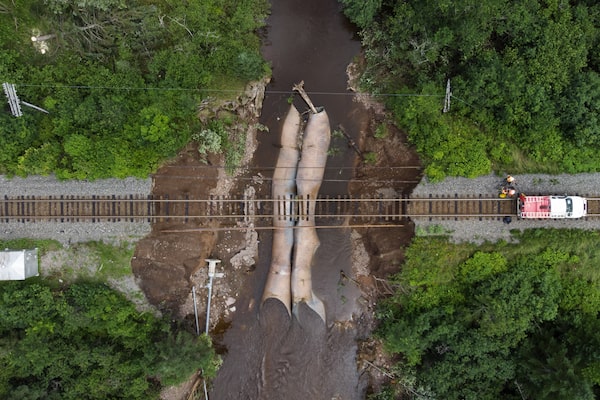
Workers with CN Rail assess the damage to a washed-out rail line outside of Truro, N.S. on July 23. A long procession of intense thunderstorms dumped record amounts of rain across a wide swath of Nova Scotia, causing flash flooding, road washouts and power outages.Darren Calabrese/The Canadian Press
Nova Scotia had well-documented evidence that it was poorly prepared for extreme flooding, but officials didn’t take steps to correct those deficiencies before a catastrophic deluge last month that killed four people and damaged homes and infrastructure in the province, according to one of the authors of a 2020 report on the issue.
Blair Feltmate, a co-author of the report and the head of the University of Waterloo’s Intact Centre on Climate Adaptation, said the provincial government was informed of the group’s findings, which were that Nova Scotia was performing poorly in eight out of nine flood-risk preparedness criteria identified by the researchers. The group found similar levels of unpreparedness, on average, in most other provinces and territories.
The criteria included producing up-to-date flood-risk maps; land-use planning to prevent people from building on floodplains; ensuring that altered watercourses wouldn’t affect flooding; and ensuring that critical infrastructure – such as telecommunications equipment, highways, water supply systems and water treatment facilities – wouldn’t be unduly impacted by flooding.
Seven senior provincial officials, most of them assistant or associate deputy ministers, reviewed and confirmed the results on behalf of the provincial government, Dr. Feltmate said.
In particular, he said, the provincial government should have taken steps to map out areas where water would flow during big storms, so flooding could be redirected using a combination of berms, diversion channels, holding ponds, cisterns and bioswales.
“Water could have been directed to safe locations to keep people and property out of harm’s way to a much greater degree than happened,” Dr. Feltmate said.
Instead, he said, the burden landed on emergency first responders.
While preparedness measures may not have prevented the four deaths, Dr. Feltmate said, the probability of lives being lost could have been significantly lowered.
Nova Scotia premier considering public alert changes after flood warning came two hours late
The Atlantic provinces have experienced a trifecta of climate change effects in recent months, according University of Toronto geography and Earth sciences professor Joseph Desloges.
This past September, post-tropical storm Fiona ravaged many parts of the region, bringing storm surges that eroded huge chunks of shoreline. This was followed by drought in Nova Scotia, which set the stage for historic wildfires that burned 151 homes in the spring. Then the province experienced heavy rainfall, which caused the flooding last month. The equivalent of three months worth of rain fell in 24 hours in some parts of the province, an effect of climate change and global warming that Dr. Desloges prefers to call “global wetting.”
“When you put more heat and energy into the atmosphere, you evaporate more water from the oceans, and that causes heavy rainfall or snow events,” he said.
“That’s no solace to those areas of the planet that are experiencing heat and drought at the moment, but what climate change really means is that, over the medium and longer term, you can expect more extremes and more variability between hot, dry, no rain and heavy extreme rainfall and storm surges.”
Nova Scotia is the only Atlantic province that delegates responsibility for floodplain mapping to its local governments – which Dr. Feltmate said is potentially problematic. Sometimes municipalities are reluctant to identify new areas as floodplains because doing this can devalue properties. An authority that is one step politically removed from mayors and local councillors, who do not want to face unhappy constituents, can make it easier to deal with resistance to change, he said.
In response to questions about what the province has done to address the problems identified in the report, Nova Scotia’s Department of Municipal Affairs and Housing and its Department of Environment and Climate Change provided a joint statement saying the province has a municipal flood-line mapping program and is creating updated hazard maps for all watersheds to help inform municipalities.
“The program will give municipalities more information they can use to help improve their preparedness and response plans for potential flood events,” provincial spokesperson Chrissy Matheson wrote, adding that municipalities are responsible for any zoning changes needed.
Ms. Matheson said the province will be hiring a flood co-ordinator and a stormwater engineer to implement flood prevention and climate change adaptation measures.
Residents can prepare for flooding ahead of time by sealing basement doors and windows, installing sump pumps, checking their insurance coverage and avoiding building new homes on flood plains, she added.